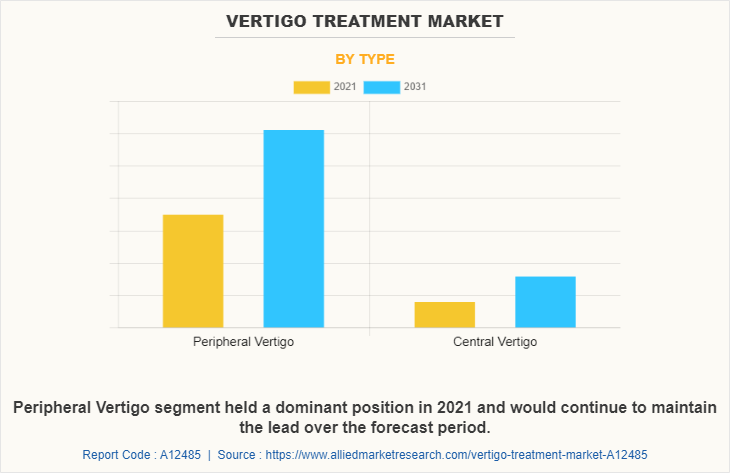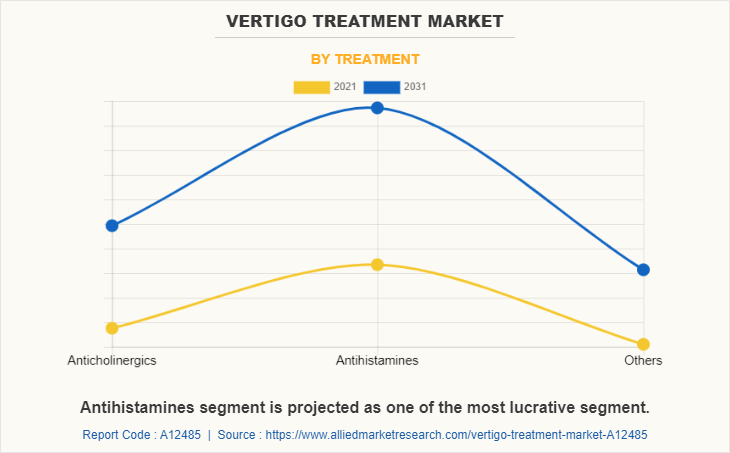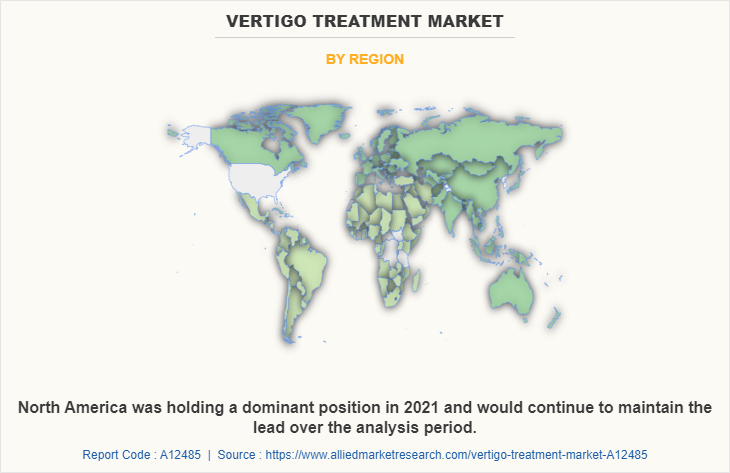Vertigo Treatment Market Research, 2031
The global vertigo treatment market size was valued at $1.3 billion in 2021, and is projected to reach $1.9 billion by 2031, growing at a CAGR of 4.4% from 2022 to 2031. Vertigo is a condition, in which a person experiences loss of balance. In addition, vertigo is the feeling of spinning, even when you are not moving. The most common causes of vertigo are head injury, benign paroxysmal positional vertigo, vestibular neuronitis, meniere’s disease, and due to consumption of certain types of medications such as cisplatin. Furthermore, the symptom of vertigo includes, nausea, vomiting, loss of balance, ringing in the ear called tinnitus, motion sickness, headaches, and difficulty in focusing.

Growth of the global vertigo treatment market is majorly driven by increase in vertigo conditions among adults as well as aged population, rising geriatric population, rise in awareness about inner ear problems and causes, and availability of treatments for vertigo conditions. Moreover, low cost of medications and availability of OTC medications are the major factors anticipated to fuel the growth of vertigo treatment market share. For instance, according to National Library of Medicine, about 64 individual per 100,000 people had history of benign paroxysmal positional vertigo in 2021.
Moreover, the global market expansion is being fueled by factors, such as increase in peripheral vertigo cases. According to university of California San Francisco, about 40% the U.S. population experience vertigo at least once in their lifetime. In addition, development of new therapies also propels the vertigo treatment market growth. For instance, Canalith repositioning or Epley maneuver is a therapy developed by Myoclinic Organization in October 2020, to treat benign paroxysmal positional vertigo more quickly.
On the other hand, side effects associated with vertigo treatment are expected to hamper the growth of vertigo treatment market share. For instance, Dimenhydrinate is an antihistamine used to prevent motion sickness, such as dizziness, nausea, and vomiting, which can cause constipation, drowsiness, and dry mouth.
Impact of COVID-19 on the Market on Vertigo Treatment Market
Coronavirus Severe acute respiration syndrome (SARS-CoV-2) is an infectious disease caused by the novel coronavirus (COVID-19), which originated in the Wuhan district in China in the late 2019, and since has spread to 212 countries. The virus was initially referred to as “novel coronavirus 2019” (2019-nCoV) by the WHO, however, on February 11, 2020, it was given the official name of SARS-CoV-2 by the International Committee on Taxonomy of Viruses. WHO declared COVID-19 as a pandemic on March 11, 2020, and by September 1, 2020, over 28.1 million people have been infected globally with over 909,000 deaths. COVID-19 symptoms include fever, cough, and shortness of breath.
Nearly all industries have been impacted by COVID-19. As coronavirus crises led to lock-down has resulted in a significant decrease in demand for the vertigo treatment across several sectors, particularly the healthcare and medical sector. The main cause of the interruption experienced by patients getting treatments for vertigo in hospitals and clinics was the risk of infection. As a result, the COVID-19 outbreak is expected to slow down the global market growth of vertigo treatment, which will have a negative effect on the market's value in 2022 and beyond.
The vertigo treatment market is segmented into Type, Treatment and Distribution channel.
The vertigo treatment market is segmented on basis of type, treatment, distribution channel, and region. On the basis of type, it is segmented into peripheral vertigo and central vertigo. By treatment, the market is bifurcated into anticholinergics, antihistamines, and others. Others include antibiotics, benzodiazepine, and antidepressant. On the basis of distribution channel, the market is segmented into hospital pharmacies, drug stores and retail pharmacies (prescription drugs and OTC drugs), and online providers.
Region-wise, the vertigo treatment industry is analyzed across North America, Europe, Asia-Pacific, and LAMEA.
By Type Segment Review
By type, the peripheral vertigo segment was the highest revenue contributor to the market in 2021, and is expected to continue this trend during the forecast period, owing to increase in prevalence of benign paroxysmal positional vertigo. On the other hand, the central vertigo segment is expected to witness a considerable growth of vertigo treatment market size during the forecast period, owing to increased problems of brain stem and cerebellum among the adults.

By Treatment Segment Review
The antihistamines segment dominated the market in 2021, owing to high efficacy of dimenhydrinate and meclizine to treat vertigo conditions, availability of OTC medications, and low cost of antihistamines.

By Distribution Channel Segment Review
The drug stores and retail pharmacies segment dominated the market in 2021, and is expected to remain dominant during the forecast period, owing to increase in patients seeking treatment for vertigo conditions and availability of medications. However, the online providers segment is expected to witness considerable growth during the forecast period.
By Distribution Channel
Drug Stores & Retail Pharmacies segment is projected as one of the most lucrative segment.
Region Type Segment Review
The North America market was dominant, in terms of revenue among other regions in 2021, owing to increase in prevalence of vertigo and rising geriatric population. On the other hand, Europe was the second-largest contributor in the market in 2021, owing to increase in awareness among the people regarding inner ear problems and availability of wide range of medications for vertigo treatment.

Some of the major companies that operate in the global vertigo treatment industry include, Amneal Pharmaceuticals Ltd., AstraZeneca Plc., Epic Pharma, LLC, GlaxoSmithKline Plc., F. Hoffmann-La Roche Ag, Intas Phrmaceuticals Ltd., Novartis Ag, Pfizer Inc., Sanofi, Sun Pharmaceutical Industries Ltd, Teva Pharmaceutical Ltd., and Viatris (Mylan N.V.).
Key Benefits For Stakeholders
- This report provides a quantitative analysis of the market segments, current trends, estimations, and dynamics of the vertigo treatment market analysis from 2021 to 2031 to identify the prevailing vertigo treatment market opportunity.
- The market research is offered along with information related to key drivers, restraints, and opportunities.
- Porter's five forces analysis highlights the potency of buyers and suppliers to enable stakeholders make profit-oriented business decisions and strengthen their supplier-buyer network.
- In-depth analysis of the vertigo treatment market segmentation assists to determine the prevailing market opportunities.
- Major countries in each region are mapped according to their revenue contribution to the global market.
- Market player positioning facilitates benchmarking and provides a clear understanding of the present position of the market players.
- The report includes the analysis of the regional as well as global vertigo treatment market trends, key players, market segments, application areas, and market growth strategies.
Vertigo Treatment Market Report Highlights
| Aspects | Details |
| Market Size By 2031 | USD 1.9 billion |
| Growth Rate | CAGR of 4.4% |
| Forecast period | 2021 - 2031 |
| Report Pages | 310 |
| By Type |
|
| By Treatment |
|
| By Distribution channel |
|
| By Region |
|
| Key Market Players | Teva Pharmaceutical Ltd., Hoffmann-La Roche, GlaxoSmithKline plc., Endo Pharmaceuticals Inc, Viatris (Mylan N.V.), Zydus Cadila, AstraZeneca plc., Novartis AG, Sun Pharmaceutical Industries Ltd., Sanofi, Pfizer Inc., Epic Pharma, LLC |
Analyst Review
The global vertigo treatment market is expected to exhibit high growth potential attributable to factors such as increase in prevalence of vertigo conditions, rise in R&D activities in drug discovery & development, and increase in awareness about inner ear problems and causes. Moreover, increasing geriatric population contributes toward the growth of the market.
Antivertigo drugs help in maintaining vestibular nuclei tone. Antihistamines help to stop nausea and vomiting. Furthermore, North America is expected to witness the highest growth, in terms of revenue, owing to rise in prevalence of vertigo, rise in healthcare expenditure, and strong presence of key players. However, Asia-Pacific is anticipated to witness notable growth, owing to rise in geriatric population and unmet medical demands during the forecast period.
The upcoming trends of Vertigo Treatment Market includes increase in prevalence of vertigo, rise in geriatric population as vertigo incidences increase with age, and rise in awareness about inner ear problems.
Vertigo condition is the leading application of Vertigo Treatment Market.
North America is the largest regional market for Vertigo Treatment.
Vertigo Treatment market is projected to reach $1,938.47 million by 2031, with a CAGR of 4.4% from 2022 to 2031.
The major companies that operate in the global vertigo treatment market include, Amneal Pharmaceuticals Ltd., AstraZeneca Plc., Epic Pharma, LLC, GlaxoSmithKline Plc., F. Hoffmann-La Roche Ag, Intas Phrmaceuticals Ltd., Novartis Ag, Pfizer Inc., Sanofi, Sun Pharmaceutical Industries Ltd, Teva Pharmaceutical Ltd., and Viatris (Mylan N.V.).
The base year is 2021 in Vertigo Treatment market.
Yes, the Vertigo Treatment market report provides PORTER Analysis.
Loading Table Of Content...



